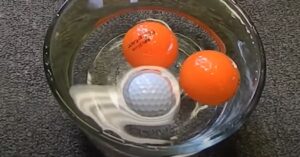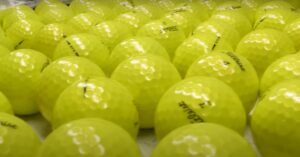Are Golf Balls Hollow? Exploring the Anatomy of a Golf Ball
Golf might seem like a straightforward sport, but its equipment holds fascinating secrets. One common question that often arises is whether golf balls are truly hollow or not.
Contrary to what one might think, golf balls are not entirely hollow. While they may have a hollow core, the interior actually consists of multiple layers, each serving a specific purpose in optimizing the ball’s performance and providing players with the ideal balance of distance and control.
Today, we’ll take a closer look at the anatomy of a golf ball to unravel this mystery and understand the science behind its design.
The Truth About Golf Ball Composition

Contrary to popular belief, golf balls are not solid, and their design is a fascinating combination of science and engineering.
In this discussion, we will explore the composition and construction of golf balls, shedding light on why they are anything but solid.
Golf Ball Layers: A Complex Structure Revealed
Golf balls are constructed with multiple layers, each serving a specific purpose. The outermost layer, known as the cover, is typically made from materials like urethane or Surlyn, providing the ball’s durability and playability.
Beneath the cover lies the mantle layer, which affects the ball’s spin and control. Finally, at the core, golf balls contain a solid rubber or liquid center, contributing to their overall performance.
Dimples: A Vital Component For Flight Efficiency
The dimples on a golf ball are not just for aesthetics; they play a crucial role in optimizing the ball’s flight.
These small indentations create turbulence in the air surrounding the ball, reducing drag and enhancing lift.
As a result, the ball can travel much farther and more accurately, making dimples an integral part of golf ball design.
Compression: The Impact On Performance And Feel
Golf balls come in different compression levels, which affects how much the ball compresses upon impact with the clubface.
Lower compression balls are softer and offer more control for slower swing speeds, while higher compression balls are firmer, providing greater distance for faster swings.
The choice of compression can significantly impact a golfer’s performance and feel during the game.
The Myth Of Solid Rubber Cores
Contrary to the common misconception, golf ball cores are not solid rubber spheres.
In the past, golf balls did have solid cores, but modern designs have evolved to include multi-layered cores, often consisting of a solid or liquid center surrounded by various materials.
These innovative core designs have improved the ball’s performance and made golf a more dynamic and enjoyable sport.
Different Types Of Balls And Their Components

Golf balls are essential components of the sport, varying in design and construction to suit diverse player preferences and skill levels. Understanding the different types of golf balls and their components is crucial for making the most of your game.
Two-Piece Golf Balls
Two-piece golf balls are the most common type used by amateur golfers. They consist of a solid rubber core surrounded by a durable outer cover made of ionomer or surlyn.
The simplicity of their design makes them highly resilient and provides maximum distance off the tee.
Due to their low spin rates, they are ideal for beginners or golfers with a higher handicap. Additionally, they are more budget-friendly compared to multi-layered balls.
Multi-Layered Golf Balls
Multi-layered golf balls are designed for advanced players seeking more control and spin. These balls feature a soft rubber core, one or more mantle layers, and a thin urethane cover.
The combination of materials allows for greater control around the greens, increased spin, and enhanced feel during shots. Golfers with moderate to low handicaps often prefer these balls for their improved performance characteristics.
Distance Golf Balls
As the name suggests, distance golf balls are engineered to maximize distance. Their high-energy core promotes a faster ball speed and increased distance off the tee.
These balls usually have a durable cover that minimizes scuffing and allows them to withstand high-velocity impacts. Golfers who prioritize distance over spin or feel may opt for these balls.
Spin/Control Golf Balls
Spin or control golf balls are designed for golfers who prefer precise shot-making and increased spin around the greens.
They usually have softer cores and urethane covers, which provide greater control and enhanced feel.
Advanced players, such as low handicappers and professionals, often choose these balls to fine-tune their shots and optimize performance.
Low-Compression Golf Balls
`
Low-compression golf balls are specifically crafted for golfers with slower swing speeds.
The soft core of these balls allows them to compress more upon impact, leading to increased distance for players with moderate swing velocities.
These balls also provide a softer feel and improved control, benefiting those with less power in their swings.
High-Compression Golf Balls
Conversely, high-compression golf balls are designed for golfers with faster swing speeds.
With a firmer core, these balls minimize excessive compression and maximize energy transfer, making them suitable for players with powerful swings.
Skilled golfers who generate high clubhead speeds often use these balls to optimize their performance.
How To Choose The Right Golf Ball For Your Game?

Choosing the right golf ball is crucial for optimizing your performance on the course. With various options available, understanding your game and the different ball characteristics will help you make an informed decision.
Step 1: Assess Your Skill Level And Swing Speed
Begin by evaluating your skill level and swing speed. Golf balls come in different compression levels, and selecting one that suits your swing speed can greatly impact your distance and control.
Step 2: Identify Your Priority – Distance Or Control
Determine whether you prioritize distance or control in your game. Some golf balls are designed to offer more distance, while others provide better control around the greens. Make a choice based on your playing style and preferences.
Step 3: Consider The Ball Construction
Golf balls have either two-piece or multi-layer construction. Two-piece balls are more durable and provide maximum distance, making them suitable for beginners and high-handicap players.
Multi-layer balls offer better control and spin, catering to intermediate and low-handicap golfers.
Step 4: Check The Spin Rates
The spin rate of a golf ball affects how it behaves in the air and on the green. High spin balls give you more control over your shots but may reduce distance, while low spin balls offer greater distance but might be harder to control.
Step 5: Opt For A Soft Or Firm Cover
Golf balls come with either a soft or firm cover. Soft-cover balls offer a better feel and spin around the greens, ideal for skilled players. Firm covers provide more durability and are suitable for players who prioritize distance.
Step 6: Experiment With Different Brands And Models
Every golf ball brand offers a range of models with unique features. Experiment with different brands and models to find the one that suits your game the best. Some golf shops even offer trial packs to help you make an informed decision.
Step 7: Consider The Budget
Golf balls come at various price points. While premium balls may have advanced features, they can be expensive. Consider your budget and strike a balance between performance and cost.
Step 8: Read Reviews And Seek Recommendations
Before making a final decision, read reviews from other golfers and seek recommendations from friends or fellow players. Real-world experiences can provide valuable insights into how a particular golf ball performs in different game situations.
Step 9: Buy In Bulk
Once you have found the right golf ball for your game, consider buying them in bulk to save money. Many manufacturers offer discounts on bulk purchases, and having a consistent ball for every round can improve your game.
Step 10: Monitor Performance And Adjust As Needed
After selecting your golf ball, monitor its performance during play. Don’t hesitate to explore other options if you notice significant changes in your game or feel it’s not meeting your expectations.
Golf ball technology is continuously evolving, so staying open to changes can benefit your performance in the long run.
Frequently Asked Questions
Golf balls have been a topic of curiosity for many players and enthusiasts. Understanding their construction is essential for improving your game. In this FAQ, we’ll address the common question, “Are golf balls hollow?”
Is The Core Of A Golf Ball Hollow?
No, the core of a golf ball is not hollow. It is a solid, compressed material designed to provide the ball’s main structure and support.
What Material Is Used For The Core?
The core is usually made of materials like synthetic rubber or resin, carefully engineered to provide the desired performance characteristics.
How Many Layers Do Golf Balls Have?
Golf balls can have either two or three layers, each serving specific purposes for distance, spin, and control.
Is The Cover Of A Golf Ball Hollow?
No, the cover of a golf ball is not hollow. It is a thin, solid layer that protects the core and contributes to the ball’s aerodynamics.
What Material Is Used For The Cover?
The cover of a golf ball is typically made of a tough, dimpled material like urethane or Surlyn®.
Are All Golf Balls The Same Size?
Yes, all golf balls are regulated by official standards to have a diameter of 1.68 inches (42.67mm).
Can Golf Balls Get Compressed During Play?
Yes, the impact of the clubface on the ball can cause some compression, especially with softer ball constructions.
How Does Compression Affect Performance?
Higher compression balls are better suited for high swing speeds, offering more control, while lower compression balls are suitable for slower swing speeds, providing more distance.
Do Hollow Golf Balls Exist?
Currently, there are no standard golf balls on the market with a completely hollow design. The construction and performance of traditional solid-core golf balls have proven to be more effective for the game.
Conclusion
Golf balls are not hollow; they have a multi-layered design consisting of a solid core, mantle layer, and outer cover.
Dimples on the ball aid in flight efficiency, and compression levels affect performance. Different types of golf balls cater to various player preferences and skill levels.
Choosing the right ball can enhance your game and enjoyment of the course.



![What Are Golf Balls Made Off? [A Material Breakdown] american standard vs bryant (15)](https://giftedgolfers.com/wp-content/uploads/2023/06/american-standard-vs-bryant-15-300x157.jpg)

